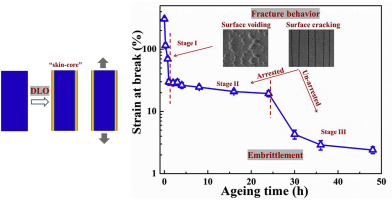Polymer Degradation and Stability ( IF 5.9 ) Pub Date : 2018-05-22 , DOI: 10.1016/j.polymdegradstab.2018.05.024 Xin-Feng Wei , Kai J. Kallio , Stefan Bruder , Martin Bellander , Hans-Henning Kausch , Ulf W. Gedde , Mikael S. Hedenqvist

|
Polyamides (PAs) frequently experience diffusion-limited oxidation (DLO) under elevated temperatures due to their combination of relatively high oxygen barrier properties and high susceptibility to, and rate of, oxidation; under DLO conditions, oxidation is uneven and limited to a thin surface layer. In this study, the reduced extensibility/embrittlement of unstabilized PA6 under DLO conditions was understood by revealing DLO-induced fracture behavior. The DLO was induced by thermally ageing PA6 samples at 180 °C; the built-up of the thin oxidized layer by ageing was revealed by infrared microscopy. Notably, the formation of the thin oxidized layer significantly reduced the strain-at-break. Depending on whether the oxidized layer was brittle, two types of surface behavior (voiding and cracking) occurred during the tensile tests, which in turn lead to three types (stages) of tensile fracture behavior. In particular, in the early stage (Stage I) of ageing, the fracture was caused by a long crack formed by the coalescence of adjacent surface voids, leading to a decrease in the strain-at-break from 300% to 30%. In Stage II, multiple surface cracks, which initiated in the oxidized layer, was arrested by the interface between the oxidized and unoxidized material, leading to an almost constant strain-at-break (at or close to the necking strain). Maximum brittleness occurred in Stage III, where a more extensive oxidation of the oxidized layer initiated cracks with high propagation rate, causing the interface to be unable to arrest the cracks.
中文翻译:

聚酰胺的扩散限制氧化:断裂行为的三个阶段
聚酰胺(PA)由于具有较高的氧气阻隔性能以及较高的氧化敏感性和氧化速率,因此经常会在高温下经历扩散限制氧化(DLO)。在DLO条件下,氧化是不均匀的,并且限于薄的表面层。在这项研究中,通过揭示DLO引起的骨折行为,可以理解DLO条件下不稳定PA6的扩展性/增强性降低。DLO是通过在180°C下热老化PA6样品引起的;红外显微镜显示了由于老化而形成的薄氧化层。值得注意的是,薄氧化层的形成显着降低了断裂应变。根据氧化层是否脆性,在拉伸试验中会发生两种类型的表面行为(空洞和开裂),这又导致了三种类型(阶段)的拉伸断裂行为。特别是,在时效的早期阶段(第一阶段),断裂是由相邻表面空隙的聚结形成的长裂纹引起的,从而导致断裂应变从300%降低至30%。在第二阶段中,在氧化层和非氧化层之间的界面阻止了始于氧化层的多个表面裂纹,从而导致了几乎恒定的断裂应变(等于或接近颈缩应变)。最大的脆性发生在阶段III,在该阶段中,氧化层的更广泛的氧化引发了具有高传播速率的裂纹,从而导致界面无法阻止裂纹。断裂是由相邻表面空隙的聚结形成的长裂纹引起的,导致断裂应变从300%降低到30%。在第二阶段中,在氧化层和非氧化层之间的界面阻止了始于氧化层的多个表面裂纹,从而导致了几乎恒定的断裂应变(等于或接近颈缩应变)。最大的脆性发生在阶段III,在该阶段中,氧化层的更广泛的氧化引发了具有高传播速率的裂纹,从而导致界面无法阻止裂纹。断裂是由相邻表面空隙的聚结形成的长裂纹引起的,导致断裂应变从300%降低到30%。在第二阶段中,在氧化层和非氧化层之间的界面阻止了始于氧化层的多个表面裂纹,从而导致了几乎恒定的断裂应变(等于或接近颈缩应变)。最大的脆性发生在阶段III中,在该阶段中,氧化层的更广泛的氧化引发了具有高传播速率的裂纹,从而导致界面无法阻止裂纹。被氧化的和未氧化的材料之间的界面阻止了氧化,导致几乎恒定的断裂应变(在或接近颈缩应变)。最大的脆性发生在阶段III中,在该阶段中,氧化层的更广泛的氧化引发了具有高传播速率的裂纹,从而导致界面无法阻止裂纹。被氧化的和未氧化的材料之间的界面阻止了氧化氢,导致几乎恒定的断裂应变(在或接近颈缩应变)。最大的脆性发生在阶段III中,在该阶段中,氧化层的更广泛的氧化引发了具有高传播速率的裂纹,从而导致界面无法阻止裂纹。



























 京公网安备 11010802027423号
京公网安备 11010802027423号